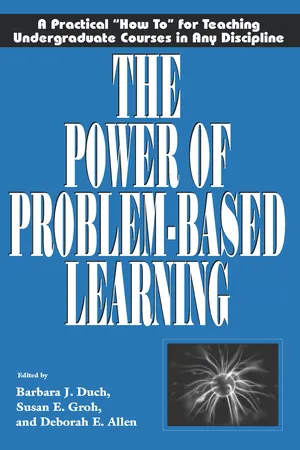
The Power of Problem-Based Learning
A Practical "How To" for Teaching Undergraduate Courses in Any Discipline
- 256 pages
- English
- PDF
- Available on iOS & Android
The Power of Problem-Based Learning
A Practical "How To" for Teaching Undergraduate Courses in Any Discipline
About this book
Problem-based learning is a powerful classroom process, which uses real world problems to motivate students to identify and apply research concepts and information, work collaboratively and communicate effectively. It is a strategy that promotes life-long habits of learning.The University of Delaware is recognized internationally as a center of excellence in the use and development of PBL. This book presents the cumulative knowledge and practical experience acquired over nearly a decade of integrating PBL in courses in a wide range of disciplines.This "how to" book for college and university faculty. It focuses on the practical questions which anyone wishing to embark on PBL will want to know: "Where do I start?"–"How do you find problems?"–"What do I need to know about managing groups?"–"How do you grade in a PBL course?"The book opens by outlining how the PBL program was developed at the University of Delaware--covering such issues as faculty mentoring and institutional support--to offer a model for implementation for other institutions.The authors then address the practical questions involved in course transformation and planning for effective problem-based instruction, including writing problems, using the Internet, strategies for using groups, the use of peer tutors and assessment. They conclude with case studies from a variety of disciplines, including biochemistry, pre-law, physics, nursing, chemistry, political science and teacher educationThis introduction for faculty, department chairs and faculty developers will assist them to successfully harness this powerful process to improve learning outcomes.
Frequently asked questions
- Essential is ideal for learners and professionals who enjoy exploring a wide range of subjects. Access the Essential Library with 800,000+ trusted titles and best-sellers across business, personal growth, and the humanities. Includes unlimited reading time and Standard Read Aloud voice.
- Complete: Perfect for advanced learners and researchers needing full, unrestricted access. Unlock 1.4M+ books across hundreds of subjects, including academic and specialized titles. The Complete Plan also includes advanced features like Premium Read Aloud and Research Assistant.
Please note we cannot support devices running on iOS 13 and Android 7 or earlier. Learn more about using the app.
Information
Table of contents
- Contents
- Preface
- 1. Why Problem-Based Learning?
- 2. Faculty Mentoring Faculty
- Appendix to Chapter 2
- 3. Make it So
- 4. Models for Problem-Based Instruction in Undergraduate Courses
- 5. Writing Problems for Deeper Understanding
- Appendix to Chapter 5
- 6. Strategies for Using Groups
- 7. Getting Started in Problem-Based Learning
- 8. Undergraduate Group Facilitators to Meet the Challenges of Multiple Classroom Groups
- 9. Assessment Strategies in a Problem-Based Learning Course
- Appendix to Chapter 9
- 10. Problem-Based Learning and the Three Cs of Technology
- 11. The Evolution of Problem-Based Learning in a Biotechnology Course
- 12. A PBL Course that Uses Research Articles as Problems
- 13. Integrating Active Learning and the Use of Technology in Legal Studies Courses
- 14. Problem-Based Learning in Large and Very Large Classes
- 15. Problem-Based Learning: Preparing Nurses for Practice
- 16. The Large and The Small of It
- Appendix to Chapter 16
- 17. PBL, Politics, and Democracy
- 18. Using Problem-Based Learning in General Chemistry
- Appendix to Chapter 18
- 19. A Skeptic's Look at PBL
- 20. PBL in Preservice Teacher Education
- 21. Introductory Physics
- Appendix 1 to Chapter 21
- Appendix 2 to Chapter 21
- Index